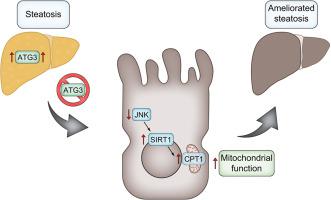Journal of Hepatology ( IF 26.8 ) Pub Date : 2021-09-21 , DOI: 10.1016/j.jhep.2021.09.008 Natália da Silva Lima 1 , Marcos F Fondevila 2 , Eva Nóvoa 1 , Xabier Buqué 3 , Maria Mercado-Gómez 4 , Sarah Gallet 5 , Maria J González-Rellan 1 , Uxia Fernandez 1 , Anne Loyens 5 , Maria Garcia-Vence 6 , Maria Del Pilar Chantada-Vazquez 6 , Susana B Bravo 6 , Patricia Marañon 7 , Ana Senra 1 , Adriana Escudero 1 , Magdalena Leiva 8 , Diana Guallar 9 , Miguel Fidalgo 1 , Pedro Gomes 10 , Marc Claret 11 , Guadalupe Sabio 8 , Marta Varela-Rey 12 , Teresa C Delgado 4 , Rocio Montero-Vallejo 13 , Javier Ampuero 13 , Miguel López 2 , Carlos Diéguez 2 , Laura Herrero 14 , Dolors Serra 14 , Markus Schwaninger 15 , Vincent Prevot 5 , Rocio Gallego-Duran 16 , Manuel Romero-Gomez 17 , Paula Iruzubieta 18 , Javier Crespo 18 , Maria L Martinez-Chantar 19 , Carmelo Garcia-Monzon 20 , Agueda Gonzalez-Rodriguez 21 , Patricia Aspichueta 22 , Ruben Nogueiras 2

|
Background & Aims
Autophagy-related gene 3 (ATG3) is an enzyme mainly known for its actions in the LC3 lipidation process, which is essential for autophagy. Whether ATG3 plays a role in lipid metabolism or contributes to non-alcoholic fatty liver disease (NAFLD) remains unknown.
Methods
By performing proteomic analysis on livers from mice with genetic manipulation of hepatic p63, a regulator of fatty acid metabolism, we identified ATG3 as a new target downstream of p63. ATG3 was evaluated in liver samples from patients with NAFLD. Further, genetic manipulation of ATG3 was performed in human hepatocyte cell lines, primary hepatocytes and in the livers of mice.
Results
ATG3 expression is induced in the liver of animal models and patients with NAFLD (both steatosis and non-alcoholic steatohepatitis) compared with those without liver disease. Moreover, genetic knockdown of ATG3 in mice and human hepatocytes ameliorates p63- and diet-induced steatosis, while its overexpression increases the lipid load in hepatocytes. The inhibition of hepatic ATG3 improves fatty acid metabolism by reducing c-Jun N-terminal protein kinase 1 (JNK1), which increases sirtuin 1 (SIRT1), carnitine palmitoyltransferase 1a (CPT1a), and mitochondrial function. Hepatic knockdown of SIRT1 and CPT1a blunts the effects of ATG3 on mitochondrial activity. Unexpectedly, these effects are independent of an autophagic action.
Conclusions
Collectively, these findings indicate that ATG3 is a novel protein implicated in the development of steatosis.
Lay summary
We show that autophagy-related gene 3 (ATG3) contributes to the progression of non-alcoholic fatty liver disease in humans and mice. Hepatic knockdown of ATG3 ameliorates the development of NAFLD by stimulating mitochondrial function. Thus, ATG3 is an important factor implicated in steatosis.
中文翻译:

抑制 ATG3 通过增加线粒体功能改善肝脂肪变性
背景与目标
自噬相关基因 3 (ATG3) 是一种酶,主要以其在 LC3 脂化过程中的作用而闻名,这对自噬至关重要。ATG3 是否在脂质代谢中起作用或导致非酒精性脂肪肝疾病 (NAFLD) 仍然未知。
方法
通过对小鼠肝脏进行蛋白质组学分析,对肝脏 p63(一种脂肪酸代谢的调节剂)进行基因操作,我们将 ATG3 鉴定为 p63 下游的新靶标。ATG3 在 NAFLD 患者的肝脏样本中进行了评估。此外,在人肝细胞系、原代肝细胞和小鼠肝脏中进行了ATG3的基因操作。
结果
与没有肝脏疾病的患者相比,在动物模型和 NAFLD 患者(脂肪变性和非酒精性脂肪性肝炎)的肝脏中诱导 ATG3 表达。此外,小鼠和人类肝细胞中ATG3的基因敲低改善了 p63 和饮食诱导的脂肪变性,而其过表达增加了肝细胞中的脂质负荷。肝脏 ATG3 的抑制通过减少 c-Jun N 末端蛋白激酶 1 (JNK1) 来改善脂肪酸代谢,从而增加去乙酰化酶 1 (SIRT1)、肉碱棕榈酰转移酶 1a (CPT1a) 和线粒体功能。SIRT1 和 CPT1a 的肝脏敲低减弱了 ATG3 对线粒体活性的影响。出乎意料的是,这些作用独立于自噬作用。
结论
总的来说,这些发现表明 ATG3 是一种与脂肪变性发展有关的新型蛋白质。
总结
我们表明自噬相关基因 3 (ATG3) 有助于人类和小鼠非酒精性脂肪肝疾病的进展。ATG3 的肝脏敲低通过刺激线粒体功能来改善 NAFLD 的发展。因此,ATG3 是涉及脂肪变性的重要因素。











































 京公网安备 11010802027423号
京公网安备 11010802027423号